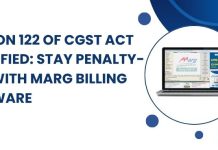As per the Goods and Services Tax (GST) regime, every registered taxpayer is required to file periodic returns with the GST authority. GSTR-6 is one such return, which needs to be filed by the Input Service Distributor (ISD). In this blog, we will understand what GSTR-6 is, who needs to file it, and how to file it.
What is GSTR-6?
GSTR-6 is a monthly return that needs to be filed by Input Service Distributors (ISD) under the GST regime. An ISD is an entity that receives input services and distributes them to other business units that operate under the same PAN (Permanent Account Number). It is a statement of inward supplies received by the ISD and the distribution of input tax credit to the recipient business units.
Who needs to file GSTR-6?
As mentioned earlier, only Input Service Distributors (ISD) need to file GSTR-6. The following entities can be classified as ISDs:
- Head offices of companies that have branches or business units in different states
- Companies that have centralized billing systems for input services
- Companies that receive input services on behalf of their branches or business units
- Any other entity that is specifically notified by the government as an ISD
How to file GSTR-6?
The process of filing GSTR-6 is similar to other GST returns. Here are the steps to file GSTR-6:
Step 1: Login to the GST portal (www.gst.gov.in) using the registered credentials.
Step 2: Navigate to the ‘Services’ tab and click on ‘Returns Dashboard’.
Step 3: Select the financial year and the return filing period (month) for GSTR-6.
Step 4: Click on ‘Prepare Online’ to initiate the return filing process.
Step 5: In the GSTR-6 form, enter the details of input tax credit received and distributed to the recipient business units.
Step 6: Once you have filled in all the details, click on ‘Preview’ to verify the information provided in the return.
Step 7: If everything is correct, click on ‘Submit’ to file the return.
Step 8: After submitting the return, you need to sign it using a digital signature certificate (DSC) or an electronic verification code (EVC).
Step 9: Once the return is filed, you can view and download the acknowledgment receipt for future reference.
Compliance requirements for GSTR-6
Here are some compliance requirements that need to be followed while filing GSTR-6:
- GSTR-6 needs to be filed by the 13th of the following month for which the return is being filed.
- The Input Service Distributor is also required to issue an ISD invoice to the recipient business units for the input tax credit distributed during the period.
- Any corrections or amendments to GSTR-6 can be made in the subsequent return filing period.
- In case of non-filing or late filing of GSTR-6, a penalty of Rs. 50 per day (Rs. 25 per day for CGST and Rs. 25 per day for SGST) will be applicable. The maximum penalty amount is Rs. 5,000.
Here are some additional information that you need to know about GSTR-6:
Types of input services included in GSTR-6
GSTR-6 includes the details of all the input services received by the Input Service Distributor (ISD) during the return filing period. This includes services like legal, accounting, advertising, consulting, and others. It is important to note that only input services and not goods are included in GSTR-6.
Recipient business units in GSTR-6
In GSTR-6, the Input Service Distributor (ISD) is required to furnish the details of the recipient business units who have received the input tax credit. The recipient business units can be the same as the ISD or any other business unit that operates under the same PAN.
ISD invoice under GSTR-6
As mentioned earlier, the Input Service Distributor (ISD) is required to issue an ISD invoice to the recipient business units for the input tax credit distributed during the period. The ISD invoice contains the details of the input tax credit distributed and the GSTIN of the recipient business unit. The recipient business unit can use this ISD invoice to claim the input tax credit in their GSTR-3B return.
GSTR-6A
GSTR-6A is an auto-populated return that is generated for the recipient business units who have received the input tax credit from the Input Service Distributor (ISD). It contains the details of the input tax credit received by the recipient business unit and can be used by them to claim the input tax credit in their GSTR-3B return. It is important for the recipient business unit to reconcile the details in GSTR-6A with their books of accounts to avoid any discrepancies.
Tips for Filing GSTR-6
Here are some tips that can help Input Service Distributors (ISD) file GSTR-6 accurately and timely:
- Maintain accurate records
ISDs should maintain accurate records of all the input services received and the input tax credit distributed to the recipient business units. This will help them file GSTR-6 accurately and avoid any discrepancies in the return.
- Reconcile GSTR-6 with books of accounts
ISDs should reconcile the details in GSTR-6 with their books of accounts to ensure that all the input services received and the input tax credit distributed have been accurately reported. Any discrepancies should be rectified before filing the return.
Conclusion
GSTR-6 is an important return that needs to be filed by Input Service Distributors (ISD) under the GST regime. It is a statement of inward supplies received by the ISD and the distribution of input tax credit to the recipient business units. The process of filing GSTR-6 is similar to other GST returns, and compliance requirements need to be followed for timely and correct filing of the return. Any non-compliance may attract penalties, and therefore, it is important for ISDs to ensure timely and accurate filing of GSTR-6 to avoid any legal or financial consequences.
Read more useful content:
Frequently Asked Questions (FAQ’s)
Q1.) Who needs to file GSTR-6?
GSTR-6 needs to be filed by Input Service Distributors (ISD) under the GST regime.
Q2.) What is the due date for filing GSTR-6?
The due date for filing GSTR-6 is the 13th of the month following the return filing period.
Q3.) What are the consequences of non-filing or late filing of GSTR-6?
Non-filing or late filing of GSTR-6 may attract a penalty of Rs. 50 per day (Rs. 25 per day for CGST and Rs. 25 per day for SGST). The maximum penalty amount is Rs. 5,000.
Q4.) What are the types of input services included in GSTR-6?
GSTR-6 includes the details of all the input services received by the Input Service Distributor (ISD) during the return filing period. This includes services like legal, accounting, advertising, consulting, and others.
Q5.) Can corrections or amendments be made to GSTR-6?
Yes, corrections or amendments to GSTR-6 can be made in the subsequent return filing period.
Q6.) What is an ISD invoice?
An ISD invoice is an invoice issued by the Input Service Distributor (ISD) to the recipient business units for the input tax credit distributed during the period.
Q7.) What is GSTR-6A?
GSTR-6A is an auto-populated return that is generated for the recipient business units who have received the input tax credit from the Input Service Distributor (ISD).
Q8.) What is the penalty for incorrect filing of GSTR-6?
The penalty for incorrect filing of GSTR-6 is Rs. 10,000 or the amount of tax evaded, whichever is higher.
Q9.) Can GSTR-6 be filed manually?
No, GSTR-6 can only be filed online through the GSTN portal.
Q10.) Is there any threshold limit for filing GSTR-6?
No, there is no threshold limit for filing GSTR-6. All Input Service Distributors (ISD) are required to file the return irrespective of the turnover.






